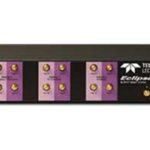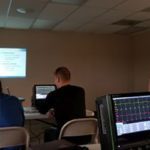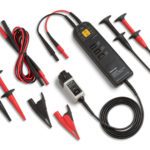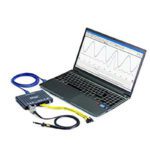Data communication rates have soared in recent years and there is every reason to believe that this trend will accelerate. Information speeds that were less than 1 Gb/sec have surpassed 10 Gb/sec. Optical communication is greater than 100 Gb/sec, with 1 Tb/sec down the road. RF wireless communications is in the mid-gigahertz range, and RF and optical communications comply with mandates by means of innovative types of modulation and low-amplitude signals. High-bandwidth oscilloscopes are required to debug these new system designs. As a result, oscilloscope designers are introducing instruments extending beyond 70 GHz.
Attaining ever-higher bandwidths as new oscilloscope models are introduced becomes an increasingly difficult task. The problem is that all components, including probes and cabling, have intrinsic capacitive and inductive values, which attenuate the signal under investigation in proportion to the highest frequency of that signal.
The quest for higher bandwidth requires new higher-frequency response components in addition to redesigned circuit boards, cabling and so on. Any circuit or conductor can be a bottleneck that will limit the overall bandwidth of the instrument. The ADC is particularly problematic. Not only are sleek new designs required to reduce parasitics, but also a higher sampling rate together with clock frequency have to be attained to satisfy Nyquist.
One answer could be heterodyning the signal down to a more manageable level, but this solution introduces additional noise, which is always an impediment to accurate measurements. The big three oscilloscope manufacturers have investigated the concept of bandwidth enhancement to adjust their instruments’ bandwidths upward by means of signal modification on a software level. Tektronix, LeCroy and Keysight have reached different conclusions. We’ll examine their methods and arguments.
Digital oscilloscopes have a limited amount of acquisition memory. (Analog oscilloscopes had no memory at all.) The memory depth sets the amount of waveform time and the number of serial packets that the instrument can capture at any given sample rate. The user can slow the time/div setting to capture longer time spans and a greater number of serial packets. But as soon as the oscilloscope exceeds its maximum time span at its maximum sample rate, the instrument will automatically reduce its sample rate. Then its inherent bandwidth and maximum sample rate limitations prevent the display of accurate waveform detail. Segmented memory can improve this situation.
Dividing the oscilloscope’s available acquisition memory into smaller segments and overlaying successive captures while the instrument is in an infinite persistence mode permits the capture and display of a larger periodic waveform than otherwise possible, reducing the possibility of missing a rare anomaly.
As manufacturers have boosted the operational frequencies of their electronic equipment, oscilloscope makers have of necessity increased the bandwidth of their instruments to remain relevant. The aspiration has been to achieve these higher spectral levels without introducing unwanted distortion. Methods for doing so have been controversial, each of the three big manufacturers emphasizing different solutions and sometimes disparaging those of their competitors. The primary methods are:
- Interleaving (previously successfully used in the ADC and now extended into the processing section to increase overall bandwidth)
- DSP boosting, consisting of separating out by means of frequency filtering those higher-frequency components that would otherwise be disproportionally attenuated, and amplifying them to compensate.
- Raw hardware, consisting of continuously redesigning signal path components, circuits and subsystems so as to reduce parasitic capacitive and inductive reactances.
LeCroy has favored the technique known as interleaving. They call it Random Interleaved Sampling (RIS). It is an acquisition mode that produces waveforms at high effective sample rates. In a LeCroy oscilloscope, the user can select RIS mode from the time base settings menu when the time base is set at or below 20 μsec.

RIS employs a hardware device known as a Time-to-Digital Converter (TDC). It places the trigger position between samples. This device charges at a uniform slope between the start of the trigger to the next sample. Following that, it discharges with a uniform, lower slope. This provides an exceptionally fine temporal resolution.
The value read from the TDC is used to bin successive acquisitions. Then, multiple acquisitions from the waveform and TDC values are used to prepare acquisitions for interleaving to form a single high sample-rate waveform.
Because the waveform results from multiple acquisitions, it follows that the interleaved waveform segments have been acquired at widely separated points in time. It does not matter when the original waveforms were acquired. The order in which they are interleaved is random.
Because of the random nature of the waveforms, the waveform must be repetitive, and in each sweep the trigger event must be the same. There can be no variation in the periodic waveform. The analog waveform must be triggered at precisely the same location at each acquisition. Any non-repetitive event, such as jitter, will invalidate the RIS process.
RIS is useful in signal integrity measurements where a TDR pulse or similar stimulus is applied to the circuit under investigation. It is also useful in device characterization where precise timing and threshold crossings are required. RIS does not work for jitter, noise measurements and eye patterns.
Tektronix has favored the technique known as DSP boosting. To gain added bandwidth, the high-frequency portion of the signal that rolls off near and beyond the bandwidth limit is amplified to compensate for the amount it is attenuated as a result of high reactance losses.
To improve oscilloscope channel response, a DSP arbitrary equalization filter is used. It extends the bandwidth, flattens the oscilloscope channel frequency response, improves phase linearity, provides better match between channels, reduces rise time, and improves time domain step response. The user controls when bandwidth enhancement is enabled. The filter is useful in:
- Rise time measurement
- Comparison of signals in multiple channels
- Overshoot and undershoot measurements
- Spectral analysis
- Eye diagrams
Keysight has favored a technique it calls Raw Hardware Performance. The basic idea is to incorporate hardware innovations that eliminate parasitics and improve physical performance with respect to bandwidth. For example, new semiconductors such as preamplifier and trigger chips are introduced in designs that will put these new devices to work.
Keysight has been acting on the theory that interleaving and DSP Boosting involve tradeoffs that undermine the quest for ever-greater bandwidth. Keysight states that as a result of its true raw hardware analog bandwidth, the 9000 X-Series oscilloscope has the exact same noise density from 1 to 2 GHz as from 31 to 32 GHz (the industry’s lowest noise density). It is also able to realize an extremely flat frequency response over the full 32-GHz range. This same raw hardware chip innovation is used in Keysight active probes so that they don’t constitute a bottleneck.
Keysight states that frequency interleaving requires more (not better) hardware along the signal path, which sets the stage for added noise and less accurate measurements.

In regard to DSP Boosting, Keysight contends the technique has a significant drawback, which is that when the signal is amplified, so is the noise of the oscilloscope. Again, increased noise means less accurate measurements.
We have examined ways in which bandwidth can be expanded to permit accurate measurement of higher-frequency signals. In terms of increasing capacitive and reducing inductive reactance, amplifying signals near the maximum bandwidth and interleaving, there are points of diminishing returns if not absolute theoretical limits that suggest entirely new approaches will be needed.






Leave a Reply
You must be logged in to post a comment.